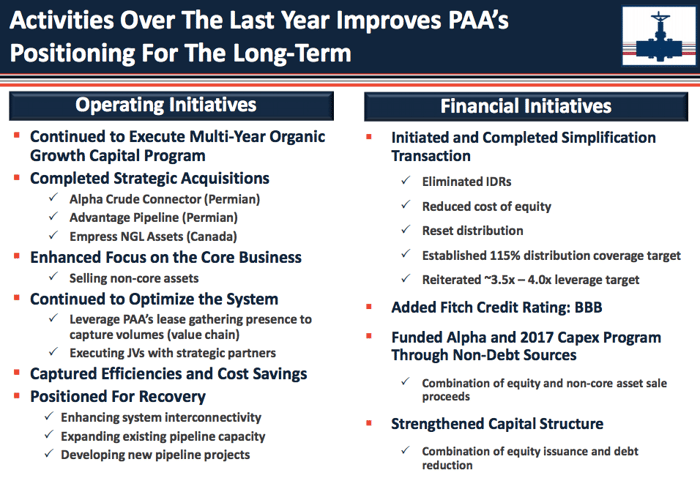When investors think about energy stocks, they often have oil drillers in mind. But by limiting their scope, they're missing out on a lot of options. Case in point: midstream companies like Buckeye Partners, L.P. (BPL) and Plains All American Pipeline, L.P. (PAA 1.95%), which help move oil and gas from where it's drilled to where it's used. Right now both partnerships have fat yields because their unit prices have fallen more than 20% over the past year. But that doesn't mean both are bargains today.
Here's what you need to know about these two beaten-up midstream energy partnerships.
Investing for the future
Buckeye Partners' units are falling because the distribution coverage has been weak lately. In fact, in the second quarter of 2017, distribution coverage fell to just 0.95. That goes along with net income per unit falling to $0.80 in the quarter from $1.07 in the same period of 2016. The company is also dealing with the loss of a key customer at one of its facilities. These are not comforting facts, but they may be providing investors with a chance to lock in a hefty 8.7% yield.

Image source: Getty Images.
For perspective, this isn't the first time that Buckeye's distribution coverage has fallen below one. The partnership's available cash flow didn't cover the distribution in 2013 or 2014, either. But the distribution kept growing just the same, and the partnership boasts a history of 22 consecutive annual increases backed by its largely fee-based pipeline and global storage business. As management takes a long-term view investing for the future, it's willing to allow distribution coverage to dip below one over the short term.
Today's big investments include the purchase of a 50% stake in global energy storage company VTTI. This move helped push Buckeye's unit count higher by around 10 million units year over year, depressing per-unit metrics. The VTTI investment has contributed to results for only one quarter at this point.
There are also longer-term projects in the works, like Buckeye's construction plans for a pipeline that will link up the prolific Permian Basin to assets the partnership owns in Texas, increasing demand for its facilities there. And Buckeye is working -- and should eventually be able -- to replace that lost customer, even if it takes a little time.
Buckeye has an impressive record of paying unitholders to stick around through the lean times so they can benefit from the good times. The company is currently in one of those difficult stretches, but if history is any guide, the investments it is making today should make up for the shortfall in time. For those willing to take on a little risk, it could be a great time to pick up a big yield while you wait for management's investment moves to pay off -- as they have before.
Hitting the reset button
Plains All American is a slightly different case. The partnership's most recent quarterly distribution was $0.55 per unit, indicating a forward yield of over 10%. However, after the company's weak results in the second quarter (the partnership reduced full-year adjusted EBITDA guidance by 8%), investors quickly priced in a distribution cut. That would be the second distribution cut at Plains since the payment was trimmed around 20% at the end of 2016.
The partnership, which has a desirable portfolio of pipelines in key markets, is basically trying to reset its business. In late 2016 it issued stock to its general partner to eliminate the GP's incentive distribution rights. That should help to reduce its cost of capital as it expands in the future. Plains is also attempting to set a distribution policy that can be supported by its fee-based assets (roughly 90% of adjusted EBITDA in the second quarter). The late-2016 distribution cut was supposed to be enough to do that, though now it appears unitholders may be in for some more pain.

Plains is moving in the right direction, but it's been a bumpy ride. Image source: Plains All American Partners, L.P.
Here's the thing: Plains All American appears to be doing the right thing for the long-term, but the changes it's making have already hit income investors where it hurts -- in the distribution. On top of that, the simplification process appears to have hit a snag. So, despite the high-yield, most investors would be better off waiting until Plains is done "simplifying" its business before jumping aboard here.
One to consider, one to avoid
Just because an energy stock is getting beaten up doesn't mean it's a bad investment. That's the case at Buckeye, which is willing to support its distribution until its investments pay off. It's done this before -- as its 22-year history of distribution growth attests -- and will likely do it again. Investors should take a close look at this partnership's 8.7% yield today while units are on sale.
Plains All American looks like it's making good long-term moves, too. But the changes it's making to simplify its business haven't been going as well as hoped. There appears to be a second distribution cut priced into the over-10% yield. Investors would be better off waiting until the company is on the other side of this simplification process. Right now it's too hard to tell if Plains is on the bargain rack or if there's more downside to come.






